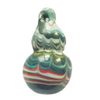分享到微信,
请点击右上角。
再选择[发送朋友]
或[分享到朋友圈]

琉璃,亦作“瑠璃”,是以各种颜色(颜色由各种金属元素产生)的人造水晶(含24%的二氧化铅)为原料,在1000多度的高温下烧制而成的稀有装饰品。其色彩流云漓彩,品质晶莹剔透、光彩夺目。
中国古代最初制作琉璃的材料,是从青铜器铸造时产生的副产品中获得的,经过提炼加工然后制成琉璃。琉璃的颜色多种多样,古人也叫它“五色石”。古时由于民间很难得到,所以当时人们把琉璃甚至看成比玉器还要珍贵。
2008年6月,琉璃烧制技艺入选国务院批准文化部确定的第二批国家级非物质文化遗产名录。
有人说,玻璃到处都是,又不值钱,有什么好说的?这样想就错了,玻璃在古代可是比金玉都值钱的宝贝,在古人眼里,玻璃比珠玉地位更高。
玻璃在中国古代有很多别称,比如缪琳、琅轩、陆琳、琉琳、硝子、药玉、罐子玉等等。现在在通常情况下,我们把全透明的归类于“玻璃”,半透明的归类于“琉璃”,不透明的归类于“料器”。这是现代人对于玻璃制品的简单归类,但在古人眼里却没这么简单。
我国的玻璃工艺在西周时就趋于成熟,在不少西周墓葬中,都发现了大量的琉璃珠和小型玻璃管。经中外专家用现代光谱仪鉴定,得出的共同结论是中国出产的琉璃成分为铅钡,这跟西方的“钠钙玻璃”是完全不同的,是两个不同的玻璃制作系统。
由于中国的铅钡玻璃是低温玻璃,虽然绚丽多彩,但是缺点也是显而易见的:质量轻、不耐高温,骤然遇到高温很容易破裂,所以中国的铅钡玻璃只有小型装饰品,以珠子、挂件为主。
西汉时,随着丝绸之路的开辟,西方的宝石、金银、玻璃器皿也随着贸易往来进入中国。魏晋南北朝时期,罗马、波斯玻璃器开始大量进入中国,与此同时高温玻璃制作技术也被中国人消化,使得中国玻璃制作技艺有所提高。但是制作产品仍然以制作小配饰为主,大型玻璃器皿仍然是以进口西方钠钙玻璃为主。宋人对来自阿拉伯的玻璃器皿极为珍视,当时福建提举市舶使的赵汝逅在《诸蕃志》中就记载了进口玻璃的优点和配方:添入南硼砂,故滋润不裂,最耐寒暑,宿水不坏,以此贵重于中国。
到了清代,中国玻璃制作在融合了西方玻璃制作技术的情况下,达到了一个前所未有的高度。当时的玻璃生产分南北两地,南方以广州为中心,北方则是以山东博山颜神镇为中心。而清庭则在康熙三十五年(1696年)在北京西安门的蚕池口建立了清宫玻璃厂,专门制作御用玻璃器直至宣统三年(1911年)为止,一直烧造不断,其中以康雍乾时期最为鼎盛,制作玻璃器也最为精美。
这个时期的琉璃器皿不再像以前的琉璃那么粗和脆弱,已经可以经受高温的考验,所以才会出现大量精美绝伦的大型琉璃器皿,而且涉及的面十分广泛,几乎囊括了所有的生活用品。在制作工艺上和表现手法上也变得丰富多彩,可以划分为画珐琅玻璃、套色玻璃、刻花玻璃、洒金玻璃、金星玻璃、缠丝玻璃等,极大的提高了玻璃器皿的艺术性和观赏性。
从颜色上看,康熙时期玻璃就色彩丰富、颜色纯正,并开始出现底款。到了雍正时期,色彩更加丰富,在康熙时期的基础上增加了玛瑙红、鸡油黄、宝石蓝、翡翠绿、蜜蜡黄等,造型上多借鉴当时的宣德炉、瓷器、玉器等,样式十分丰富。
到了乾隆时期,料器得到了更大的发展空间,是清代玻璃制作的极盛期,这个时期的料器应用更为广泛,颜色更是达到了二十余种之多,这大概是跟乾隆皇帝的农家乐审美有密切的关系的。料器的制作工艺十分讲究,有金星料、点彩、夹金、绞丝、搅胎、套料等,手法上有雕刻、描彩、描金、画珐琅等。



Glass, also known as "glass", is a rare ornament made of artificial crystals (containing 24% lead dioxide) of various colors (produced by various metal elements) as raw materials and fired at a high temperature of more than 1000 degrees. Its color is flowing clouds and colorful, and its quality is crystal clear and dazzling.
In ancient China, the first materials for making colored glass were obtained from the by-products produced during bronze casting. After refining and processing, they were made into colored glass. There are many colors of colored glass. The ancients also called it "five colored stone". In ancient times, it was difficult for people to get it, so people even regarded glass as more precious than jade.
In June 2008, the glaze firing technique was selected into the second batch of national intangible cultural heritage list approved by the State Council and determined by the Ministry of culture.
Some people say that glass is everywhere and worthless. What can I say? It's wrong to think so. Glass was more valuable than gold and jade in ancient times. In the eyes of the ancients, glass had a higher status than pearl jade.
There were many nicknames for glass in ancient China, such as Miao Lin, Lang Xuan, Lu Lin, Liu Lin, nitrate, medicine jade, jar jade and so on. Now, under normal circumstances, we classify fully transparent as "glass", translucent as "colored glass" and opaque as "feeder". This is a simple classification of glass products by modern people, but it is not so simple in the eyes of the ancients.
China's glass technology tended to mature in the Western Zhou Dynasty. A large number of glass beads and small glass tubes were found in many Western Zhou tombs. Through the identification of modern spectrometers by Chinese and foreign experts, the common conclusion is that the glass produced in China is composed of lead and barium, which is completely different from the "sodium calcium glass" in the West. It is two different glass making systems.
Because China's lead barium glass is low-temperature glass, although it is colorful, its disadvantages are also obvious: it is light in weight, not resistant to high temperature, and it is easy to break when suddenly encountering high temperature. Therefore, China's lead barium glass has only small decorations, mainly beads and pendants.
In the Western Han Dynasty, with the opening of the Silk Road, Western gemstones, gold, silver and glassware also entered China with trade. During the Wei, Jin, southern and Northern Dynasties, Roman and Persian glassware began to enter China in large quantities. At the same time, the high-temperature glass making technology was digested by the Chinese people, which improved the Chinese glass making technology. However, the production products are still mainly small accessories, and the large glassware is still mainly imported western soda lime glass. The people of Song Dynasty cherished the glassware from Arabia very much. At that time, Zhao rumet, the shipping envoy of Fujian Province, recorded the advantages and formula of imported glass in zhufanzhi: adding South borax, it is moist and does not crack, the most resistant to cold and heat, and the water is not bad, so it is valuable in China.
In the Qing Dynasty, Chinese glass production reached an unprecedented height with the integration of Western glass production technology. At that time, glass production was divided into North and south, with Guangzhou as the center in the South and Yanshen town in Boshan, Shandong as the center in the north. The Qing court established the Qing palace glass factory in canchikou, Xi'an gate, Beijing in the 35th year of Kangxi (1696), specializing in the production of imperial glass. It has been burning continuously until the third year of Xuantong (1911). Among them, the kangyongqian period was the most prosperous and the production of glass was the most exquisite.
The glazed utensils of this period are no longer as thick and fragile as the previous glazed utensils, and can withstand the test of high temperature. Therefore, there are a large number of exquisite large-scale glazed utensils, and they cover a wide range of aspects, including almost all daily necessities. In terms of production technology and expression techniques, it has also become rich and colorful, which can be divided into painted enamel glass, colored glass, engraved glass, gold sprinkled glass, Venus glass, filament wrapped glass, etc., which greatly improves the artistry and appreciation of glassware.
In terms of color, the glass in Kangxi period was rich in color and pure in color, and began to appear at the end. By the time of Yong Zheng, the colors were more abundant. On the basis of the Kangxi period, agate, red, yellow, sapphire blue, emerald green and honey wax yellow were added.
In the Qianlong period, there was more room for the development of utensils, which was the heyday of glass making in the Qing Dynasty. In this period, utensils were more widely used, and there were more than 20 colors, which was probably closely related to the aesthetics of farmhouse music of Emperor Qianlong. The production process of the feeder is very particular, including Venus material, color stippling, gold inclusion, stranding, tire stirring, material setting, etc. the techniques include carving, color drawing, gold drawing, enamel painting, etc.

分享到微信,
请点击右上角。
再选择[发送朋友]
或[分享到朋友圈]

